List of metropolitan areas in Asia
Asia is one of the world's fastest-growing continents, with increasing urbanisation and a high growth rate for cities. Tokyo, in Japan, is the world's largest metropolitan area by population.
The populations of the given cities are obtained from five sources:
- Cities
- World Atlas
- National Official Estimate (NOE)
Out of these five sources, the highest estimate is shown in bold. The cities are ranked on the basis of their highest estimate of population. Some remarks:
- The official statistics for Chinese cities are for municipalities which usually extend well beyond the urban areas and comprise a substantial rural population. When such statistics exceed the estimated figures, as in the case for Chongqing, Wuhan and Shenyang, they are not taken into account.
- The figure for Shanghai from City Population includes the city of Suzhou (some 100 km or 62 miles northwest of Shanghai), which is not included in other estimates or in the official statistics and therefore is not taken into account.
- The figure for Guangzhou from City Population is for the urban population of the Guangdong province, also which includes the cities Shenzhen, Dongguan, Zhongshan, Jiangmen and Huizhou. The area has not yet been developed into a single metropolitan area and therefore this figure is not taken into account. Shenzhen and Dongguan are listed separately in this table.
- Demographia and world Atlas give figures for the contiguous cities of Quanzhou, Jinjiang and Shishi. City Population includes these three cities in its figures for Xiamen (population 4-4.8 million), giving a total population of 10,000,000. However, Xiamen is not actually contiguous with the three other cities and this statistic is not taken into account.
- The figure for Delhi from City Population includes the cities of Faridabad, Ghaziabad, Gurgaon, which are not included in other estimates or in the official statistics and therefore is not taken into account.
- The figure for Mumbai from City Population includes the cities of Bhiwandi, Kalyan, Thane, Ulhasnagar, Vasai-Virar which are not included in other estimates or in the official statistics and therefore is not taken into account.
The table is color-coded to show which region of Asia each city is in. The color-code key is as follows:
With twenty cities, East Asia accounts for half of cities under this list, with China having the most with fifteen cities, South Asia comes second with ten cities, seven of which are in India. Southeast Asia accounts for seven cities and West Asia with just four cities.
List
| Area | Image | Country | Metro Population (2024 est.)[1] |
Demographia (2017 est.)[2] |
UN WC (2016 est.)[3] |
World Atlas (2017 est.)[4] |
Official or Other |
Est. Year |
|---|---|---|---|---|---|---|---|---|
| Guangzhou | 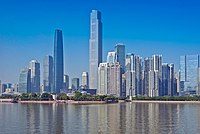
|
70,100,000[5] | 19,075,000 | Guangzhou 13,070,000[6] Foshan 7,089,000[6] |
20,597,000 | 12,700,800[7] | – | |
| Jakarta | 
|
29,200,000 | 35,386,000 | 32,594,159 | 30,539,000 | 54,842,885[8] | 2023 | |
| Mumbai | 
|
27,100,000 | 23,355,000 | 21,357,000[6] | 17,712,000 | 47,800,000[9] | 2001 | |
| Delhi | 
|
34,600,000 | 29,617,000 | 26,454,000[6] | 24,998,000 | 41,034,555 [10][11] | 2011 | |
| Tokyo | 
|
41,000,000 | 37,977,000 | 38,140,000[12] | 37,843,000 | 31,714,000[13] | 2005 | |
| Shanghai | 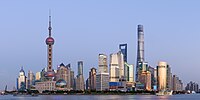
|
40,800,000 | 23,390,000 | 24,484,000[10] | 23,416,000 | 23,019,148[14] | 2010 | |
| Manila | 
|
27,200,000 | 24,245,000 | 13,131,000[6] | 24,123,000 | 11,553,427[15] | 2007 | |
| Seoul | 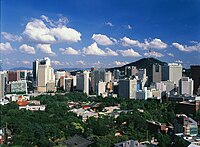
|
25,100,000 | 21,794,000 | Seoul 9,979,000[10] Incheon 2,711,000[10] |
23,480,000 | 26,015,868 [16] | 2007 | |
| Dhaka | 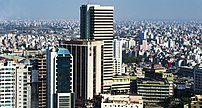
|
22,500,000 | 16,820,000 | 18,237,000[12] | 15,669,000 | 12,797,394[17] | 2008 | |
| Beijing | 
|
21,200,000 | 20,415,000 | 21,240,000[6] | 21,009,000 | 19,612,368[18] | 2010 | |
| Bangkok | 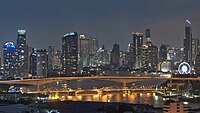
|
21,200,000 | 15,645,000 | 9,440,000[12] | 14,998,000 | 8,249,117 [19] | 2010 | |
| Osaka-Kobe-Kyoto (Keihanshin) | 
|
17,700,000 | 17,075,000 | 20,337,000[12] | 17,440,000 | 16,663,000[13] | 2005 | |
| Surabaya | 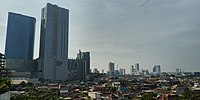
|
5,900,000 | 6,556,000 | 9,958,656 | 6,251,766 | 19,659,028[20] | 2023 | |
| Kolkata | 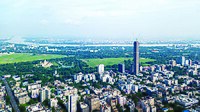
|
18,560,853 | 18,560,853 | 18,560,853[6] | 18,560,853 | – | – | |
| Chengdu | 
|
17,300,000 | 11,050,000 | 7,820,000[6] | 10,376,000 | – | – | |
| Tehran | 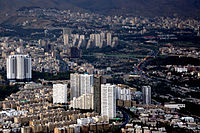
|
16,500,000 | 13,805,000 | 8,516,000[10] | 13,532,000 | 13,422,366[21] | 2006 | |
| Istanbul[22] | 
|
15,900,000 | 15,154,000 | 14,365,000[10] | 14,163,989 | 15,519,267[23] | 2019 | |
| Bangalore | 
|
14,200,000 | 10,535,000 | 10,456,000[6] | 8,728,906 | 8,499,399 | 2011[24] | |
| Ho Chi Minh City | 
|
13,900,000 | 10,380,000 | 7,498,000[6] | 8,957,000 | 7,955,000 | 2016 | |
| Hangzhou | 
|
13,900,000 | 6,820,000 | – | 7,275,000 | – | – | |
| Chongqing | 
|
10,900,000 | 7,990,000 | 13,744,000[6] | 7,217,000 | 28,846,170[25][26] | 2010 | |
| Tianjin | 
|
11,500,000 | 13,245,000 | 11,558,000[6] | 10,920,000 | 12,938,224[27] | – | |
| Shenzhen | 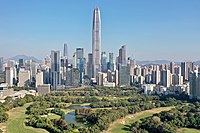
|
included in Guangzhou | 12,775,000 | 10,828,000 | 12,084,000[6] | 10,357,938[28] | – | |
| Chennai | 
|
12,600,000 | 12,395,000 | 10,163,000[6] | 9,714,000 | 8,696,010 | 2022[24] | |
| Wuhan | 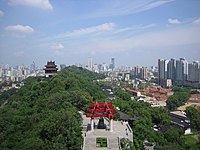
|
12,200,000 | 7,895,000 | 7,979,000[6] | 7,509,000 | 9,785,392[29][30] | – | |
| Hyderabad | 
|
11,400,000 | 9,305,000 | 9,218,000[6] | 8,754,000 | – | – | |
| Nagoya | 
|
10,500,000 | 10,070,000 | 9,434,000[12] | 10,177,000 | 9,046,000[13] | 2005 | |
| Taipei | 
|
9,950,000 | 8,550,000 | 2,669,000[6] | 7,438,000 | 8,916,653 [21] | 2010 | |
| Zhengzhou-Xingyang | 
|
9,800,000 | 7,005,000 | 4,539,000[6] | 4,942,000 | – | – | |
| Ahmedabad | 
|
9,600,000 | 7,645,000 | 7,571,000[6] | 7,186,000 | – | – | |
| Kuala Lumpur | 
|
9,300,000 | 7,590,000 | 7,047,000[6] | 7,088,000 | 1,768.00 [31][32] | 2015 | |
| Nanjing | 9,300,000 | 6,320,000 | – | 6,155,000 | – | – | ||
| Bandung | 
|
6,950,000 | 7,203,000 | – | 6,251,766 | 9,054,175[33] | 2023
| |
| Shenyang | 
|
8,700,000 | 7,935,000 | 6,438,000[6] | 6,078,000 | 8,106,171[34] | – | |
| Dongguan | 
|
Included in Guangzhou | 8,310,000 | 7,469,000[6] | 8,442,000 | – | – | |
| Singapore | 
|
7,850,000 | 5,825,000 | 5,717,000[6] | 5,624,000 | 5,607,300 [35] | 2017 | |
| Hanoi | 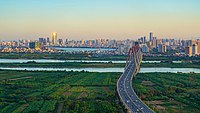
|
7,150,000 | 7,785,000 | 3,790,000[6] | 3,715,000 | – | – | |
| Baghdad | 
|
7,650,000 | 6,960,000 | 6,811,000[6] | 6,625,000 | – | – | |
| Riyadh | 
|
7,500,000 | 6,030,000 | 6,540,000[10] | 5,666,000 | 6,506,000 | 2014 | |
| Hong Kong | 
|
7,250,000 | 7,330,000 | – | 7,246,000[6] | 7,246,000 | – | |
| Quanzhou-Shishi-Jinjiang | 
|
Included in Xiamen [36] | 6,480,000 | 1,469,000[6] | 6,710,000 | – | – |
See also
References
- ^ Brinkhoff, Thomas (1 January 2024). "The Principal Agglomerations of the World". CityPopulation. Retrieved 4 March 2024.
- ^ "Demographia World Urban Areas 13 Th Annual Edition: 2017:04" (PDF). Retrieved 2 August 2017.
- ^ "World cities in 2016: Data Booklet" (PDF). The United Nations: Population Division. Retrieved 2 August 2017.
- ^ "World's Largest Cities". Archived from the original on 28 August 2017. Retrieved 2 August 2017.
- ^ This figure is for the urban population of the Guangdong province, which includes Shenzhen, Dongguan, Zhongshan, Jiangmen, and Huizhou, which has not yet been developed into a single metropolitan area
- ^ a b c d e f g h i j k l m n o p q r s t u v w x y z aa Urban Agglomeration
- ^ 广州市2010年第六次全国人口普查主要数据公报 (in Chinese). Statistics Bureau of Guangzhou. 16 May 2011. Archived from the original on 20 July 2011. Retrieved 25 May 2011.
- ^ Kemendari 2023 census
- ^ "Basic Statistics for Mumbai". MMRDA: Mumbai Metropolitan Region Development Authority. Retrieved 7 November 2009.
- ^ a b c d e f g City proper
- ^ "Delhi Population 2022 | Sex Ratio & Literacy rate 2024". www.census2011.co.in.
- ^ a b c d e Metropolitan Area
- ^ a b c "Table 2.10 Population of Three Major Metropolitan Areas" (PDF). Ministry of Internal Affairs and Communications (Japan). Archived from the original (PDF) on 13 November 2009. Retrieved 7 November 2009.
- ^ "Shanghai sixth national census in 2010 Communiqué on Major Data, Chinese: 上海市2010年第六次全国人口普查主要数据公报". Shanghai Municipal Statistics Bureau. 3 May 2011. Archived from the original on 26 November 2011. Retrieved 16 August 2011.
- ^ "Metro Manila at a glance". Metropolitan Manila Development Authority. Retrieved 25 August 2009.[dead link]
- ^ "Seoul National Capital Area Statistics" (in Korean). Korean National Statistical Office. Retrieved 6 November 2009.
- ^ "Statistical Pocket Book, 2008" (PDF). Bangladesh Bureau of Statistics. Archived from the original (PDF) on 19 April 2009. Retrieved 28 August 2009.
- ^ "Communiqué of the National Bureau of Statistics of People's Republic of China on Major Figures of the 2010 Population Census". National Bureau of Statistics of China. Archived from the original on 27 July 2013.
- ^ "National Statistical Office of Thailand" (PDF). Archived from the original (PDF) on 1 May 2016. Retrieved 3 August 2017.
- ^ Kemendari 2023 census
- ^ a b "Monthly Bulletin of Interior Statistics 2011.4". Department of Statistics, Ministry of the Interior, Taiwan/R.O.C. Archived from the original on 29 March 2014.
- ^ Istanbul is a transcontinental city straddling Eurasia. The majority of its residents live in the commercial and historical centre on the European side, and about a third of its population lives in suburbs on the Asian side of the Bosphorus, however the population figure includes the whole city.
- ^ "The Results of Address Based Population Registration System (2019)". Turkish Statistical Institute. 31 December 2019. Retrieved 9 August 2020.
- ^ a b "Provisional Population Totals, Census of India 2011 - Urban Agglomerations/Cities having population 1 lakh and above" (PDF). Archived from the original (PDF) on 1 January 2016.
- ^ 2010 Census
- ^ Figure for the municipality which extend well beyond the urban area (31,816 sq mi)
- ^ "Communiqué of the National Bureau of Statistics of People's Republic of China on Major Figures of the 2010 Population Census[1] (No. 2)". National Bureau of Statistics of China. 29 April 2011. Archived from the original on 27 July 2013. Retrieved 18 November 2011.
- ^ 深圳市2010年第六次全国人口普查主要数据公报[1] (in Chinese). Shenzhen Municipal Statistic Bureau. 12 May 2014. Archived from the original on 4 August 2011. Retrieved 28 July 2011.
- ^ "武汉市2010年第六次全国人口普查主要数据公报". Wuhan Statistics Bureau. 10 May 2011. Archived from the original on 25 October 2011. Retrieved 31 July 2011.
- ^ Figure for the municipality which extend well beyond the urban area (3,279.71 sq mi)
- ^ Federal Territory of Kuala Lumpur
- ^ Population projections for 2015
- ^ Kemendari 2023 census
- ^ "武汉市2010年第六次全国人口普查主要数据公报". Shenyang Statistics Bureau. 20 May 2011. Archived from the original on 15 August 2013. Retrieved 18 November 2011.
- ^ Statistic Singapore [1] Archived 29 November 2015 at the Wayback Machine retrieved 2014/08/02
- ^ City Population includes these three cities in its figures for Xiamen (population 4-4.8 million), giving a total population of 10,000,000. However Xiamen is not actually contiguous
